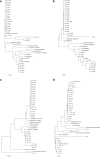Update of the helminth fauna in Eurasian lynx (Lynx lynx) in Poland
- PMID: 29948208
- PMCID: PMC6061059
- DOI: 10.1007/s00436-018-5953-0
Update of the helminth fauna in Eurasian lynx (Lynx lynx) in Poland
Abstract
The Eurasian lynx (Lynx lynx) is a strictly protected species of large carnivore in Poland. It inhabits forest complexes in north-eastern Poland and the Carpathian region in southern Poland. The status of the lynx within Poland requires special attention because its range decreased between 1980 and 2001 and has not yet recovered. One of the factors negatively affecting lynx populations is diseases, particularly parasites. The helminth fauna of the Eurasian lynx is not fully known in Poland. Previous coprological studies revealed that Polish lynx have been infected with seven species of nematodes, three species of cestodes, and one species of trematode. In this study, we present new data based on examination of opportunistically collected lynx carcasses. The aim of the study was to complement data on the helminth fauna of Eurasian lynx inhabiting Poland based on morphological and molecular analysis of parasites. Four species of cestodes-Taenia lynciscapreoli, Mesocestoides lineatus, Spirometra sp., and Taenia krabbei-were found for the first time in Eurasian lynx from Poland and three previously reported species of nematodes-Ancylostoma tubaeforme, Toxascaris leonina, and Toxocara cati-were confirmed. Larvae of Trichinella britovi were also detected in Eurasian lynx in Poland for the first time.
Keywords: Carnivores; Endangered species; Eurasian lynx; Felidae; Helminth fauna.
Conflict of interest statement
The authors declare that they have no competing interests.
Figures


Similar articles
-
Coprological study on helminth fauna in Eurasian lynx (Lynx lynx) from the Białowieza Primeval Forest in eastern Poland.J Parasitol. 2008 Aug;94(4):981-4. doi: 10.1645/GE-1440.1. J Parasitol. 2008. PMID: 18576790
-
Helminth species diversity and biology in the bobcat, Lynx rufus (Schreber), from Nebraska.J Parasitol. 1985 Apr;71(2):227-34. J Parasitol. 1985. PMID: 3998960
-
Helminth fauna of the Iberian lynx, Lynx pardinus.J Helminthol. 1998 Sep;72(3):221-6. doi: 10.1017/s0022149x00016473. J Helminthol. 1998. PMID: 9765373
-
[Helminths of carnivores relevant to veterinary practice].Tierarztl Prax. 1986;14(2):265-73. Tierarztl Prax. 1986. PMID: 3526635 Review. German.
-
Studies on the helminth parasites of birds from Egypt: 1-trematoda and cestoda.J Egypt Soc Parasitol. 1996 Apr;26(1):207-16. J Egypt Soc Parasitol. 1996. PMID: 8721241 Review.
Cited by
-
Trichinella britovi infection and muscle distribution in free-living martens (Martes spp.) from the Głęboki Bród Forest District, Poland.Int J Parasitol Parasites Wildl. 2020 Jun 17;12:176-180. doi: 10.1016/j.ijppaw.2020.06.003. eCollection 2020 Aug. Int J Parasitol Parasites Wildl. 2020. PMID: 32612926 Free PMC article.
-
Rodents as intermediate hosts of cestode parasites of mammalian carnivores and birds of prey in Poland, with the first data on the life-cycle of Mesocestoides melesi.Parasit Vectors. 2020 Feb 22;13(1):95. doi: 10.1186/s13071-020-3961-2. Parasit Vectors. 2020. PMID: 32087754 Free PMC article.
-
Multispecies reservoir of Spirometra erinaceieuropaei (Cestoda: Diphyllobothridae) in carnivore communities in north-eastern Poland.Parasit Vectors. 2020 Nov 10;13(1):560. doi: 10.1186/s13071-020-04431-5. Parasit Vectors. 2020. PMID: 33168087 Free PMC article.
-
Diversity and biology of Spirometra tapeworms (Cestoda: Diphyllobothriidea), zoonotic parasites of wildlife: A review.Int J Parasitol Parasites Wildl. 2024 May 23;24:100947. doi: 10.1016/j.ijppaw.2024.100947. eCollection 2024 Aug. Int J Parasitol Parasites Wildl. 2024. PMID: 39040598 Free PMC article. Review.
-
High Toxocara cati prevalence in wild, free-ranging Eurasian lynx (Lynx lynx) in Finland, 1999-2015.Int J Parasitol Parasites Wildl. 2022 Feb 9;17:205-210. doi: 10.1016/j.ijppaw.2022.02.004. eCollection 2022 Apr. Int J Parasitol Parasites Wildl. 2022. PMID: 35198374 Free PMC article.
References
-
- Abuladze KI. Taeniata—the tapeworms of animals and humans and diseases caused by them. Foundations of Cestodology. Moscow: Nauka; 1964. p. 540.
-
- Andren H, Linnell JDC, Liberg O, Andersen R, Danell A, Karlsson J, et al. Survival rates and causes of mortality in Eurasian lynx (Lynx lynx) in multi-use landscapes. Biol Conserv. 2006;131:23–32. doi: 10.1016/j.biocon.2006.01.025. - DOI
MeSH terms
Grants and funding
LinkOut - more resources
Full Text Sources
Other Literature Sources

